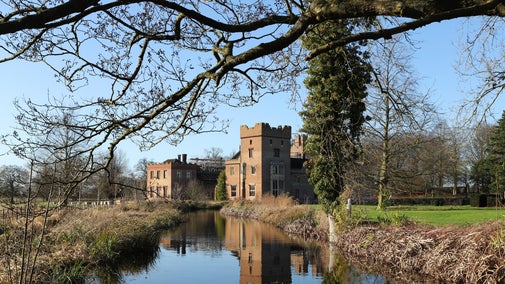
Donate
Everyone needs nature, now more than ever. Donate today and you could help people and nature to thrive at the places we care for.

Near Newtown Harbour on the Isle of Wight you will find wildflower meadows, filled with lofty grasses and blooms that turn the fields into a haze of pinks and purples in the summer. Learn about the work we’re doing to keep Newtown’s meadows a special habitat for butterflies and insects.
If you’re lucky enough to visit Newtown in just the right light, sometimes you can make out the humps and bumps of ridge and furrow in the fields that surround the sleepy hamlet. This tells us that the land has been used for farming for hundreds of years. For the last 500 years or so, it’s thought the meadows have been grazed with sheep and cattle. Today, we carry on this grazing tradition with our tenant's Belted Galloway cattle and our own Hebridean sheep.
To ensure that the meadows remain healthy, we never use artificial fertiliser. This means that nettles and modern rye grass don’t have the nutrient-rich soil to support them, allowing for more diverse grasses and flowers to grow. As there are lots of different types of plants growing in the soil, there are fewer nutrients available, which helps to continue the cycle.
Avoiding artificial fertiliser also helps to protect the health of the estuary. Artificial fertiliser can run into the water and cause algal bloom, which would be damaging to the creatures that live here.

Sheep and cows are wonderful at recycling. Seeds are spread back into the soil through their dung, meaning the goodness is returned to the land rather than being stripped out as it would be if it was cut for hay. Their dung is even a home for beetles.
Hebridean sheep were introduced at Newtown back in the 1990s. They are excellent at scrub control, preferring to browse coarse vegetation rather than flowers such as orchids and cowslips. They'll happily eat docks, thistle flowers and nettles.
In addition, they can tolerate harsh weather and survive well on a mixed diet of plants that certain modern breeds of sheep would struggle with.
Hebridean sheep help to restore and maintain the meadows at Newtown, where we want to encourage delicate wildflowers.
We're looking at ways to focus sheep grazing in areas we need to control woody growth, rather than cutting it with a tractor, and this will help to reduce our reliance on fossil fuels.
The cattle at Newtown belong to our farm tenant but the breed originated in Scotland. They are hardy and also good at eating the coarser vegetation. As they use their tongues to pluck grass, they complement the sheep grazing by keeping areas of longer grass short, allowing areas of finer grass to flourish.

At the edge of Water's Copse is an ancient woodland of oak, ash and hazel. These trees are rarely touched by the team at Newtown. Most of Walter's Copse is a wood that has grown up on former Medieval strip fields. When ploughing ceased, they were probably grazed, and many of the flowers you'll see in the woods are meadow species.
The parts of the wood that have grown on what was once meadowland now include a network of rides. The edges of these rides are cut in a varied pattern to let in light, which allows flowers and the many insects and butterflies that come with them to flourish.
Part of the wood called Town Copse is managed on a traditional fourteen year coppice rotation. The cut hazel is used in hedge laying and to make bundles of faggots, which help protect some path edges around the harbour from wave erosion. Red squirrels and dormice benefit from a good supply of hazel nuts too.
Our definition of close or effective control is:

Everyone needs nature, now more than ever. Donate today and you could help people and nature to thrive at the places we care for.
Discover all about visiting Newtown, Isle of Wight, with your four-legged friend. Newtown is a one pawprint rated place.

Explore the Isle of Wight's nature reserve with wildflower meadows, creeks, and a unique town hall. Visit the visitor centre for an explorer pack to help kids connect with nature. This summer check out the Medieval Randy-O Fayre.

Now a quiet backwater, Newtown was once a medieval town that went on to play a huge role in the brickmaking and salt production industries. Discover more about its history.

We believe that nature, beauty and history are for everyone. That’s why we’re supporting wildlife, protecting historic sites and more. Find out about our work.

Read about our strategy, which focuses on restoring nature, ending unequal access and inspiring more people.
